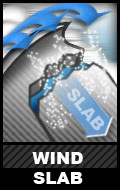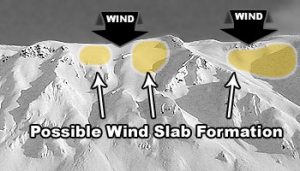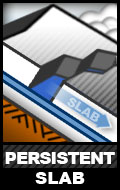Avalanche Danger Forecast
Issued Friday, January 8, 2021 at 11pm for the greater Anchorage area Western Chugach Mountains (i.e. Chugach State Park). View map of primary forecast area here.
Avalanche danger is expected to stay within the moderate spectrum through this forecast period.
Expect danger to be the highest through Saturday due to strong winds.
Danger is expected to be higher in eastern (deeper in the mountains) and southern (closer to Turnagain Arm) areas of the park due to these areas having received more precipitation recently (a few to several inches of new snow in the past 24 hours at Indian Pass and eastern end of Eklutna Lake).
Variable and hardpacked snow with widespread sastrugi and “slide-for-life” conditions exist on upper elevation slopes in the core forecast area. While observers were surprised to find isolated areas with good surface conditions for skiing on Friday, there hasn’t been enough of a refresh to repair damage from the pre-New Year’s chinook wind event (and winds have continued to batter alpine slopes this week).
This bad news for skiers may be good news for hikers and climbers, as the generally dense and hardpacked snow makes travel without skis relatively efficient.
Avalanche Problems:
 Small (D1) wind slabs are possible above 2500′ on leeward terrain steeper than 35º.
Small (D1) wind slabs are possible above 2500′ on leeward terrain steeper than 35º.
These are expected to be more of a hazard in regard to causing a fall or loss of control, rather than burial (although be mindful of terrains traps), which could be disastrous on steep or exposed terrain given the “slide-for-life” hardpacked conditions that exist in many areas.
Be on the lookout for red flags of wind slab danger: blowing snow and active wind loading, small but indicative recent natural wind slabs, and shooting cracks.
Wind slabs are most likely to exist below corniced areas and along the lee sides of ridges and cross-loaded features like gullies:
Human triggered persistent slabs up to D2.5 in size are possible on all aspects above 2500′ where the terrain is steeper than 35º. Old, shallow wind slabs are possible in specific areas (upper elevation leeward terrain) and larger hard slabs in isolated areas.
This is a low probability, but potentially high consequence, avalanche problem. While predominantly dormant, these persistent slabs are unpredictable. Such hard slabs have a tendency to release above and around a human trigger, rather than at the trigger’s feet, which can make escape difficult. In addition, hard slab avalanche debris is more likely to cause trauma than debris from soft snow.
Diverse and widespread persistent weak layers exist in the snowpack. Faceted snow exists above and below crusts in some areas, sandwiched between wind packed layers in many areas, and a basal weak layer of advanced facets and depth hoar is widespread.
As always, be on the lookout for red flag warnings of avalanche danger. Collapsing (aka “whumphing“) and shooting cracks would be the most likely, although red flags are not generally expected to be indicators of avalanche danger this forecast period. Understanding the snowpack where you intend to travel will require more in-depth analysis in the next few days: digging snowpits, conducting instability tests, and analyzing snowpack stratigraphy (layering).
Terrain management is simply the best way to avoid tricky avalanche problems: don’t expose yourself to terrain capable of producing a dangerous hard slab.
Before traveling on or under terrain that has the potential to avalanche think about the consequences, and have a plan (to escape the avalanche, for re-grouping, and rescue).
Keep in mind that short days with a lot of darkness this time of year increase the difficulty of mountain travel and the consequences of an accident.
Click the hyperlinks and icons to learn more.




